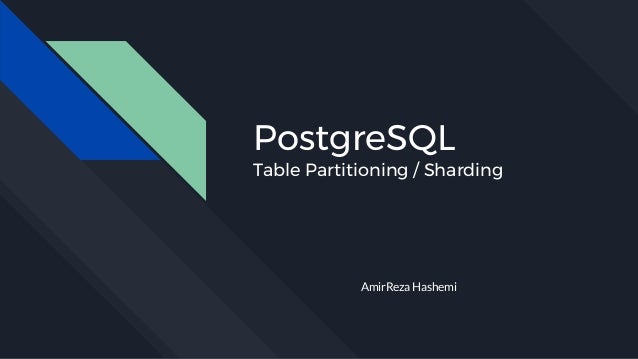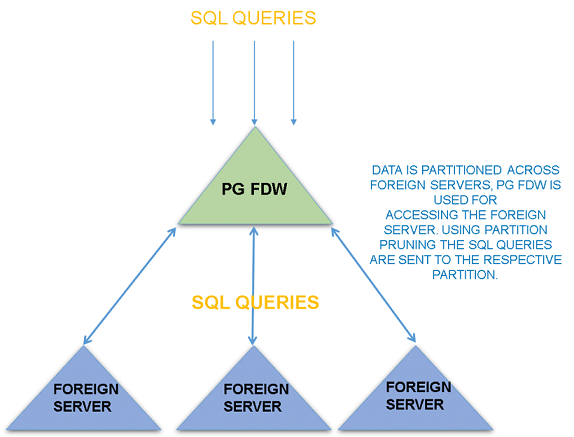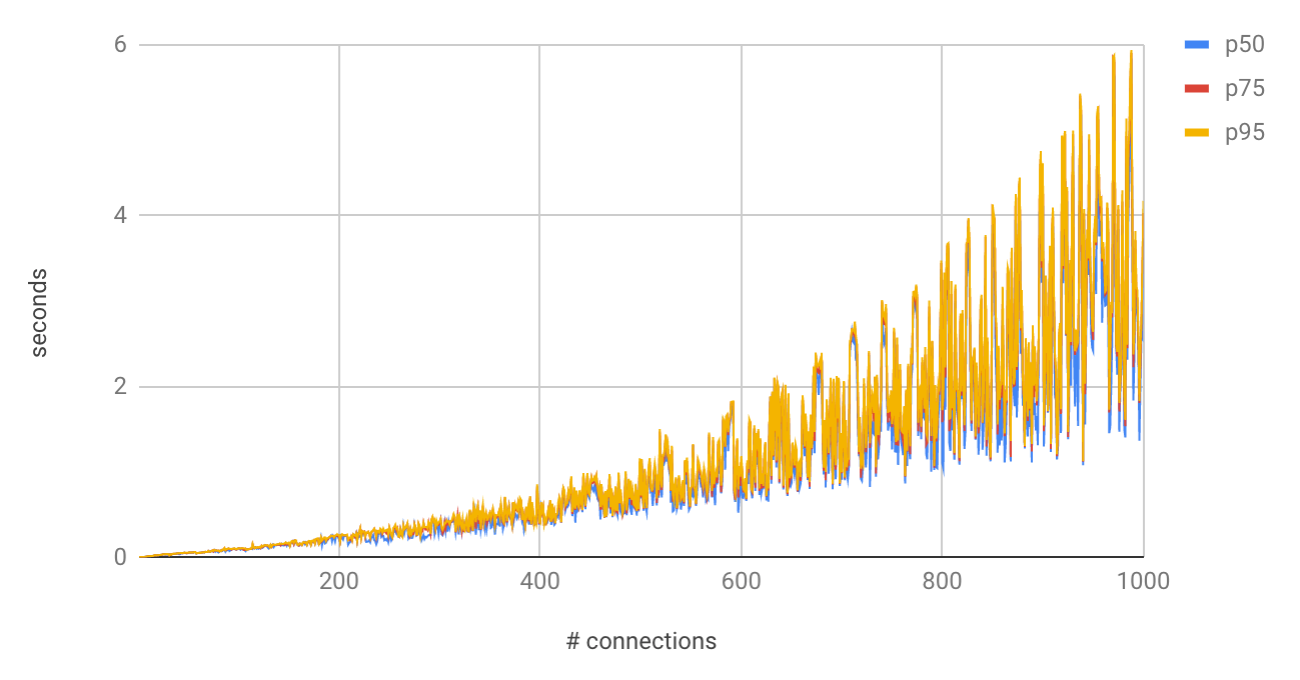on
17+ Postgresql partitioning performance ideas in 2021
Postgresql Partitioning Performance. I have a query which was executing in 30 secs before one of its table parititioned and after partitioning the query is ever running. The default and recommended setting of constraint_exclusion is actually neither on nor off but an intermediate setting called partition which causes the technique to be applied only to queries that are likely to be working on partitioned tables. The table that is divided is referred to as a partitioned table. Depending on how you need to work with the information being stored Postgres table partitioning can be a great way to restore query performance and deal with large volumes of data over time without having to resort to changing to a different data store.
 How To Monitor Postgresql 12 Performance With Omnidb Part 2 2ndquadrant Postgresql From 2ndquadrant.com
How To Monitor Postgresql 12 Performance With Omnidb Part 2 2ndquadrant Postgresql From 2ndquadrant.com
All rows inserted into a partitioned table will be routed to one of the partitions based on the value of the partition key. Partitioning refers to splitting one logically large table into smaller pieces which in turn distribute heavy loads across smaller pieces also known as partitions. I have a foreign table with 250M or so rows and 50 or so columns with a UUID as the primary key. And while creating a partitioned table structure itself is not complicated the migration of a table on live system can be tricky. Im pondering approaches to partitioning large materialized views and was hoping for some feedback and thoughts on it from the perform minds. Partitioning data is a well known way to optimize big tables into smaller ones using a given attribute.
I have a query which was executing in 30 secs before one of its table parititioned and after partitioning the query is ever running.
The right file system and the right RAID level can make a real difference too. Table that is recently partitioned is ysm_yield_session_master. This is the simple case and it is partition pruning at planning time. Good storage performance is the key to good PostgreSQL database performance. Partitioning data is a well known way to optimize big tables into smaller ones using a given attribute. And while creating a partitioned table structure itself is not complicated the migration of a table on live system can be tricky.
 Source: 2ndquadrant.com
Source: 2ndquadrant.com
Depending on how you need to work with the information being stored Postgres table partitioning can be a great way to restore query performance and deal with large volumes of data over time without having to resort to changing to a different data store. Reload older partitions so they are available to the master partition. Im pondering approaches to partitioning large materialized views and was hoping for some feedback and thoughts on it from the perform minds. The table that is divided is referred to as a partitioned table. All rows inserted into a partitioned table will be routed to one of the partitions based on the value of the partition key.
 Source: buckenhofer.com
Source: buckenhofer.com
Performance testing will make sure its still in acceptable range. For this reason you should try to always include your partition key in the where clause of your queries such that it overlaps as few partitions as possible ideally 1. Queries to the foreign table have high latency. The table that is divided is referred to as a partitioned tableThe specification consists of the partitioning method and a list of columns or expressions to be used as the partition key. Instead of date columns tables can be partitioned on a country column with a table for each country.
 Source: buckenhofer.com
Source: buckenhofer.com
But storage is not the only parameter that contributes to good performance. Strategically PostgreSQL partitioning helps to reduce the total cost of ownership for storing large amounts of data. All rows inserted into a partitioned table will be routed to one of the partitions based on the value of the partition key. And while creating a partitioned table structure itself is not complicated the migration of a table on live system can be tricky. The partitioning feature in PostgreSQL was first added by PG 81 by Simon Rigs it has based on the concept of table inheritance and using constraint exclusion to exclude inherited tables not needed from a query scan.
 Source: cybertec-postgresql.com
Source: cybertec-postgresql.com
And while creating a partitioned table structure itself is not complicated the migration of a table on live system can be tricky. Depending on how you need to work with the information being stored Postgres table partitioning can be a great way to restore query performance and deal with large volumes of data over time without having to resort to changing to a different data store. Partitioning tables in PostgreSQL can be as advanced as needed. The default and recommended setting of constraint_exclusion is actually neither on nor off but an intermediate setting called partition which causes the technique to be applied only to queries that are likely to be working on partitioned tables. Most of the documentation on partitioning Ive read through simply uses partitioning to.
 Source: mtr-design.com
Source: mtr-design.com
Partitioning can be done on multiple columns such as both a date and a country. Most of the documentation on partitioning Ive read through simply uses partitioning to. There are several ways to define a partition table such as declarative partitioning. Take the time to let that last piece of the solution sink in. Performance testing will make sure its still in acceptable range.
 Source: highgo.ca
Source: highgo.ca
Users can take better advantage of scaling by using declarative partitioning along with foreign tables using postgres_fdw. This is the simple case and it is partition pruning at planning time. The right file system and the right RAID level can make a real difference too. Im pondering approaches to partitioning large materialized views and was hoping for some feedback and thoughts on it from the perform minds. History Review New features Better DDL Better Performance Before Declarative Partitioning Early partitioning introduced in PostgreSQL 81 2005 Heavily based on relation inheritance from OOP Novelty was constraint exclusion a sort of theorem prover using queries and constraints Huge advance at the time.
 Source: za.pinterest.com
Source: za.pinterest.com
Queries to the foreign table have high latency. Postgresql Slow performance query after table partitioning. All other partitions will just be ignored and that of course is a performance improvement. This is the simple case and it is partition pruning at planning time. The performance and the scalability of partitioning.
 Source: prog.world
Source: prog.world
The default and recommended setting of constraint_exclusion is actually neither on nor off but an intermediate setting called partition which causes the technique to be applied only to queries that are likely to be working on partitioned tables. All other partitions will just be ignored and that of course is a performance improvement. I have a query which was executing in 30 secs before one of its table parititioned and after partitioning the query is ever running. History Review New features Better DDL Better Performance Before Declarative Partitioning Early partitioning introduced in PostgreSQL 81 2005 Heavily based on relation inheritance from OOP Novelty was constraint exclusion a sort of theorem prover using queries and constraints Huge advance at the time. Instead of date columns tables can be partitioned on a country column with a table for each country.
 Source: 2ndquadrant.com
Source: 2ndquadrant.com
Queries to the foreign table have high latency. Constraint exclusion is a query optimization technique that improves performance for partitioned tables SET constraint_exclusion on. We will help you to improve your IO system to match your requirements. PostgreSQL offers a way to specify how to divide a table into pieces called partitions. Queries to the foreign table have high latency.
 Source: in.pinterest.com
Source: in.pinterest.com
PostgreSQL partitioning is technically the breaking down of large tables and indexes into smaller pieces for performance scalability reliability and load-balancing. Partitioning refers to splitting one logically large table into smaller pieces which in turn distribute heavy loads across smaller pieces also known as partitions. All other partitions will just be ignored and that of course is a performance improvement. Users can take better advantage of scaling by using declarative partitioning along with foreign tables using postgres_fdw. Declarative Partitioning PostgreSQL allows you to declare that a table is divided into partitions.
 Source: in.pinterest.com
Source: in.pinterest.com
PostgreSQL offers a way to specify how to divide a table into pieces called partitions. Partitioning can be done on multiple columns such as both a date and a country. Partitioning tables in PostgreSQL can be as advanced as needed. Take the time to let that last piece of the solution sink in. And while creating a partitioned table structure itself is not complicated the migration of a table on live system can be tricky.
 Source: pinterest.com
Source: pinterest.com
The exclusion constraint will basically do. The table that is divided is referred to as a partitioned tableThe specification consists of the partitioning method and a list of columns or expressions to be used as the partition key. The partitioning feature in PostgreSQL was first added by PG 81 by Simon Rigs it has based on the concept of table inheritance and using constraint exclusion to exclude inherited tables not needed from a query scan. Users can take better advantage of scaling by using declarative partitioning along with foreign tables using postgres_fdw. The right file system and the right RAID level can make a real difference too.
 Source: prog.world
Source: prog.world
Partitioning data is a well known way to optimize big tables into smaller ones using a given attribute. For this reason you should try to always include your partition key in the where clause of your queries such that it overlaps as few partitions as possible ideally 1. Depending on how you need to work with the information being stored Postgres table partitioning can be a great way to restore query performance and deal with large volumes of data over time without having to resort to changing to a different data store. The exclusion constraint will basically do. Partitioning helps to scale PostgreSQL by splitting large logical tables into smaller physical tables that can be stored on different storage media based on uses.
 Source: slideshare.net
Source: slideshare.net
History Review New features Better DDL Better Performance Before Declarative Partitioning Early partitioning introduced in PostgreSQL 81 2005 Heavily based on relation inheritance from OOP Novelty was constraint exclusion a sort of theorem prover using queries and constraints Huge advance at the time. Partitioning can be done on multiple columns such as both a date and a country. Performance testing will make sure its still in acceptable range. There are several ways to define a partition table such as declarative partitioning. Users can take better advantage of scaling by using declarative partitioning along with foreign tables using postgres_fdw.
 Source: br.pinterest.com
Source: br.pinterest.com
Queries to the foreign table have high latency. I have a foreign table with 250M or so rows and 50 or so columns with a UUID as the primary key. All other partitions will just be ignored and that of course is a performance improvement. There are several ways to define a partition table such as declarative partitioning. History Review New features Better DDL Better Performance Before Declarative Partitioning Early partitioning introduced in PostgreSQL 81 2005 Heavily based on relation inheritance from OOP Novelty was constraint exclusion a sort of theorem prover using queries and constraints Huge advance at the time.
 Source: wiki.postgresql.org
Source: wiki.postgresql.org
The default and recommended setting of constraint_exclusion is actually neither on nor off but an intermediate setting called partition which causes the technique to be applied only to queries that are likely to be working on partitioned tables. PostgreSQL 963 on Ubuntu 1604 in the Google Cloud. The right file system and the right RAID level can make a real difference too. Partitioning can be done on multiple columns such as both a date and a country. All other partitions will just be ignored and that of course is a performance improvement.
 Source: blog.dbi-services.com
Source: blog.dbi-services.com
Reload older partitions so they are available to the master partition. The default and recommended setting of constraint_exclusion is actually neither on nor off but an intermediate setting called partition which causes the technique to be applied only to queries that are likely to be working on partitioned tables. Table that is recently partitioned is ysm_yield_session_master. The table that is divided is referred to as a partitioned table. History Review New features Better DDL Better Performance Before Declarative Partitioning Early partitioning introduced in PostgreSQL 81 2005 Heavily based on relation inheritance from OOP Novelty was constraint exclusion a sort of theorem prover using queries and constraints Huge advance at the time.
 Source: rbranson.medium.com
Source: rbranson.medium.com
Postgresql Slow performance query after table partitioning. We will help you to improve your IO system to match your requirements. History Review New features Better DDL Better Performance Before Declarative Partitioning Early partitioning introduced in PostgreSQL 81 2005 Heavily based on relation inheritance from OOP Novelty was constraint exclusion a sort of theorem prover using queries and constraints Huge advance at the time. The exclusion constraint will basically do. The declaration includes the partitioning method as described above plus a list of columns or expressions to be used as the partition key.